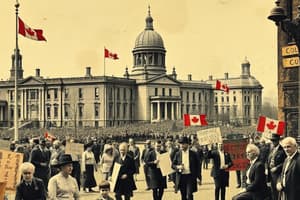Podcast
Questions and Answers
What were the different benefits for the Canadian government from Treaties 1 to 7?
What were the different benefits for the Canadian government from Treaties 1 to 7?
Securing Canada's claim to lands north of the US-Canada border, enabling the construction of the Canadian Pacific Railway, and opening the lands of the North-West Territories to agricultural settlement.
What was the purpose of Treaties 8 to 11?
What was the purpose of Treaties 8 to 11?
To make it easier for the government to access natural resources in northern Canada and to open the West for settlement.
What were the Numbered Treaties used for?
What were the Numbered Treaties used for?
To assimilate Indigenous peoples into Canadian society, encouraging them to adopt the values and behaviors of white settlers.
Why did some Indigenous leaders sign the treaties?
Why did some Indigenous leaders sign the treaties?
What led to disputes between the Canadian government and Indigenous people regarding the treaties?
What led to disputes between the Canadian government and Indigenous people regarding the treaties?
What were the Numbered Treaties and when were they signed?
What were the Numbered Treaties and when were they signed?
What was the historical context behind the Canadian government's desire to expand westward?
What was the historical context behind the Canadian government's desire to expand westward?
How did the Canadian government plan to address Indigenous claims to the lands acquired from the Hudson Bay Company?
How did the Canadian government plan to address Indigenous claims to the lands acquired from the Hudson Bay Company?
What were the key provisions of the Numbered Treaties for Indigenous people?
What were the key provisions of the Numbered Treaties for Indigenous people?
What was the significance of the 1850 Robinson Treaties in relation to the negotiation of new treaties with Indigenous people?
What was the significance of the 1850 Robinson Treaties in relation to the negotiation of new treaties with Indigenous people?
Study Notes
The Numbered Treaties
- The Numbered Treaties, from Treaties 1 to 11, were signed between the Canadian government and Indigenous peoples from 1871 to 1921.
- The primary purpose of Treaties 1 to 7 was to facilitate westward expansion, enabling the construction of the Canadian Pacific Railway and settling the land.
Purpose of Later Treaties
- Treaties 8 to 11, signed from 1899 to 1921, focused on acquiring land for resource extraction, such as mining and logging.
Key Benefits for Canadian Government
- The Numbered Treaties allowed the Canadian government to acquire large tracts of land for settlement, agriculture, and resource extraction.
- The treaties enabled the construction of the Canadian Pacific Railway, connecting the country from coast to coast.
Indigenous Perspectives
- Some Indigenous leaders signed the treaties to ensure the protection of their people, culture, and way of life.
- They believed the treaties would provide a mutually beneficial relationship, granting them rights and protection in exchange for land.
Disputes and Conflicts
- Disputes arose between the Canadian government and Indigenous peoples due to differing interpretations of the treaties, unfulfilled promises, and the erosion of Indigenous rights.
- The government's failure to uphold treaty obligations and the encroachment of settlers on Indigenous land led to conflicts.
Historical Context
- The Canadian government sought to expand westward to connect the country, facilitate economic growth, and assert sovereignty over the western territory.
- The government planned to address Indigenous claims by negotiating treaties, acquiring land from the Hudson's Bay Company, and relocating Indigenous peoples to reserves.
Robinson Treaties and Their Significance
- The 1850 Robinson Treaties, signed with the Ojibwe and Huron tribes, set a precedent for future treaty negotiations, providing a model for the Numbered Treaties.
- These treaties demonstrated that the government recognized Indigenous peoples' Aboriginal title to the land, paving the way for future negotiations.
Key Provisions for Indigenous People
- The Numbered Treaties provided Indigenous peoples with reserve land, annual payments, hunting and fishing rights, and certain rights to traditional practices.
- The treaties also promised education, healthcare, and other services, aiming to assimilate Indigenous peoples into Canadian society.
Studying That Suits You
Use AI to generate personalized quizzes and flashcards to suit your learning preferences.
Description
Explore the list of Numbered Treaties and the years they were signed, and delve into the historical context of Canadian government's expansion westward after Confederation. Learn about the agreements and the significance of the lands involved.




